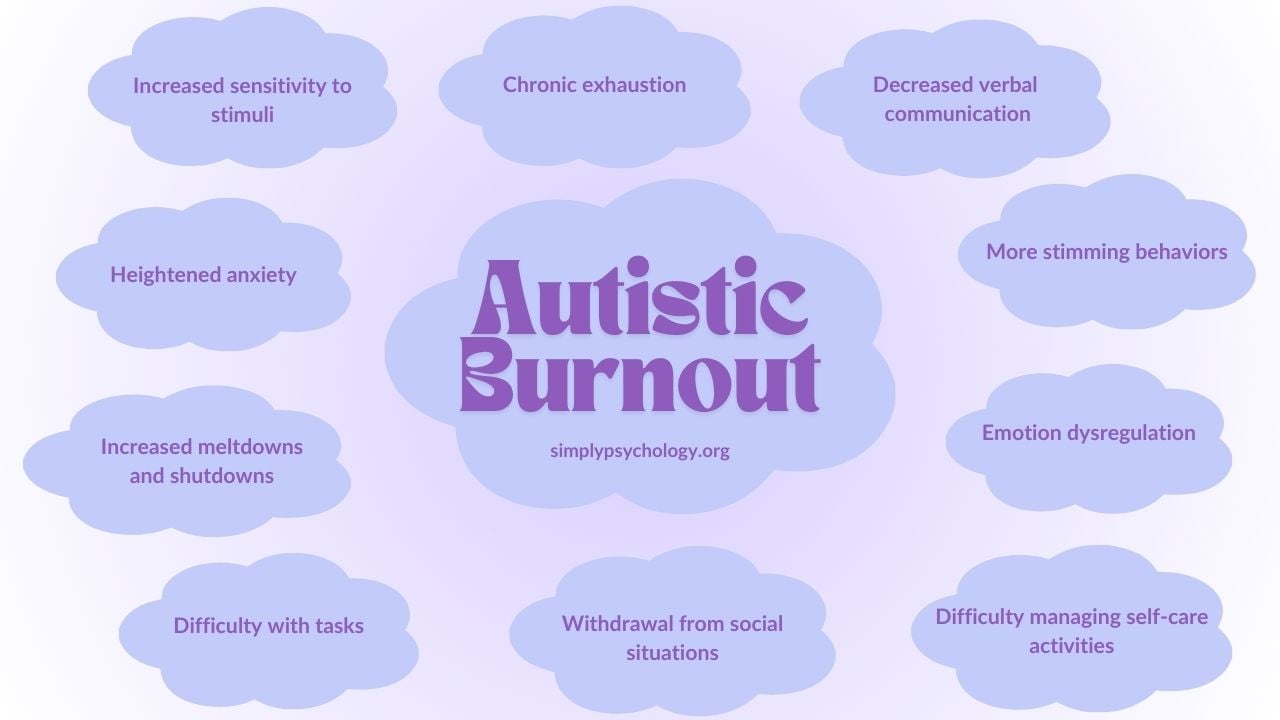Autistic burnout is a debilitating condition characterized by chronic exhaustion, loss of skills, and reduced tolerance to stimuli that significantly impact the lives of many autistic individuals.
Autistic burnout typically first emerges during adolescence or early adulthood and can have severe, recurring effects on physical and mental well-being, quality of life, and the pursuit of personal goals.
While research on autistic burnout is still limited, insights from the autistic community and a growing body of studies shed light on its causes, characteristics, and potential strategies for prevention and recovery.

Autism advocate Orion Kelly describes autistic burnout as an intense level of physical, emotional, and mental depletion that can manifest as depression, anxiety, or profound sadness.
What does autistic burnout look like?
Raymaker et al. (2020) identified three main characteristics or signs of autistic burnout:
Chronic exhaustion
This can be described as a pervasive tiredness and depletion of energy from over-extending oneself.
One person explained it as “Having all of your internal resources exhausted beyond measure and being left with no clean-up crew.”
When I was young, I was often described as tired all the time, which had nothing to do with a lack of sleep.
Loss of skills
During burnout, autistic individuals may experience a wide-ranging loss of skills that they had before the burnout, such as speech, executive functioning, memory, self-care, and activities of daily living. Many described these skills as not returning to baseline afterward.
I became very withdrawn at school and found it mentally taxing to speak, so I often remained quiet. Other people who are experiencing burnout may find it difficult to get out of bed, shower, or complete simple chores.
“For me the really, really scary part of burnout is you don’t know whether or not you’re gonna get those skills back.” (From Raymaker et al., 2020)
Reduced tolerance to stimulus
Autistic individuals can have heightened sensitivity to stimuli and a lowered ability to filter out stimuli during burnout. This can result in sensory overload, meltdowns, shutdowns, and avoidance of settings and activities that were previously tolerable.
“There’s too much talking—too much sensory, too much interaction…I spent a week on the couch because I did too much.” (From Raymaker et al., 2020)
Many autistic individuals may also have difficulty regulating their emotions due to this heightened sensitivity.
Dr. Neff, an autistic psychologist, explains: “I’m not typically an irritable person, but during burnout, even the slightest sensory trigger can completely overwhelm me. It’s as if my sensory threshold has become incredibly thin and delicate.”
Other signs of autistic burnout
- Reduced distress tolerance
- Increase in self-stimulatory behavior (stimming)
- Feeling disabled or unable to do things you could normally do
- Self-critical thoughts about why you can’t just push through it
- Needing to retreat from the world, turn off lights, lie in bed
- Avoiding interaction and commitments
- Loss of interest in things that normally spark curiosity or bring joy
Autistic Burnout vs. Depression
Autistic burnout may be mistaken for bouts of depression.
There have been many times in my life when I experienced periods of what I believed to be depression. These periods of sadness would come and go, and I assumed I had seasonal depression despite these sad spells being seemingly random, happening at any point during the year.
After realizing that I am autistic, I have realized that perhaps what I experience is actually autistic burnout.
While autistic burnout and depression share some similarities, such as low energy levels, there are key differences.
Paul from Autism From The Inside points out that in depression, individuals often lose interest in all activities, including hobbies and special interests, whereas in burnout, the idea of taking time off to rest is appealing.
Moreover, rest and relaxation can gradually improve burnout symptoms, but falling back into burnout can occur if adequate rest is not taken before expending energy again. In contrast, depression often persists regardless of the amount of rest.
To regain energy, depression may require increased stimulation through exercise, creativity, and socialization, while burnout necessitates decreased energy output through breaks and rest.
Causes of Autistic Burnout
Feedback from the autistic community indicates that burnout is often caused by the stress of long-term efforts to conform to neurotypical expectations and standards of behavior.
This can include:
Masking or camouflaging
One of the primary causes of autistic burnout, according to research, is the constant effort to mask or camouflage autistic traits to fit in and meet societal expectations.
Masking requires an enormous amount of energy to continuously monitor and modify responses, as it involves processes that occur more intuitively for neurotypical individuals.
Prolonged social interactions where I felt the need to mask would often cause my burnout. For example, in a group setting, I would expend a lot of energy focused on using appropriate facial expressions and responses, suppressing my self-stimulatory (stimming) behaviors, and fixating on the impression I was giving.
Burnout would either result in needing to isolate at home for several days or suddenly becoming quiet, withdrawn, and looking miserable while still in the social situation.
Routine changes
Autistic individuals often rely on routines and predictability to navigate daily life. However, adulthood brings more frequent and significant changes, such as transitions in work or family life, which can be overwhelming and trigger burnout.
For example, becoming a new parent could trigger burnout for autistic individuals. Having a new baby can come with disrupted sleep patterns, feedings at various points throughout the day, and, in general, needing to adapt to a new way of living.
In autistic children, you may find that they experience burnout during the transition of moving up a grade or changing schools, for instance.
The challenge of adapting to these changes while managing other responsibilities can rapidly deplete energy reserves.
Overcompensating or people-pleasing
The pressure to meet the expectations of others and the desire to avoid negative consequences can lead autistic individuals to overcompensate or engage in people-pleasing behaviors.
For example, some autistic people may take on extra work or responsibilities at school or in the workplace to prove their capabilities or to avoid being seen as incapable or difficult.
Or, they may accept social invitations despite feeling overwhelmed or needing alone time out of fear of disappointing others or being perceived as rude.
This constant effort to conform and suppress natural autistic tendencies can be mentally and emotionally taxing, contributing to burnout.
Expectations and societal pressures
Autistic burnout could result from neurotypical pressures put on the autistic person. These pressures can come from various sources, including family, social circles, work environments, and broader societal norms.
Examples of pressures that could trigger an autistic burnout:
- To be independent and self-sufficient without recognizing the need for support or accommodations
- To work a traditional 9-5 job in an office setting, which may not accommodate sensory needs or alternative communication styles
- To be productive and high-achieving
- To attend social events such as parties and networking and to have a wide social circle
The lack of societal support and understanding of the fluctuating abilities of autistic people can exacerbate these pressures.
Sensory overload
Autistic individuals often have heightened sensitivity to sensory stimuli, which can lead to overload and contribute to burnout.
Everyday environments like workplaces or social settings can be overstimulating, and the constant effort to manage and compensate for these sensory challenges can be exhausting.
For example, I know that if I worked in an office environment that had bright overhead lights, constant overlapping chatter from coworkers, and the heating on too high, these all may contribute to my senses feeling overloaded on a daily basis.
Moreover, the lack of ability to restructure one’s life to reduce exposure to sensory overload, due to systemic barriers, economic factors, or responsibilities, can perpetuate the cycle of burnout.
To summarize, It is possible that all or most of these causes interact with each other and are not distinct. The combination of these factors can lead to a vicious cycle of pushing beyond one's limits, burning out, and never fully recovering before experiencing burnout again. Understanding these causes is crucial for developing strategies to prevent and manage autistic burnout.
Recovering from Autistic Burnout
To recover from autistic burnout, Orion Kelly advises identifying and eliminating stressors, being mindful of triggers that cause sensory overload or meltdowns, withdrawing from challenging situations when experiencing burnout, and taking ample time to rest and recharge.
While this can be difficult for autistic adults with various obligations, managing triggers is crucial for preventing and recovering from burnout.
A study of autistic individuals found that acceptance, social support, unmasking, reducing expectations, allowing more downtime, engaging in naturally autistic behaviors, accommodations at school/work, assistance with daily tasks, improved self-knowledge, self-advocacy, and setting boundaries can all help alleviate or prevent autistic burnout.
According to another study, self-awareness of limits, controlling exposure to stressors, and employing coping strategies like stimming and engaging with special interests can be protective against burnout. However, alexithymia (difficulty identifying emotions) may increase burnout risk by making it harder to recognize warning signs.
The autistic community possesses valuable knowledge about autistic burnout and generously shares experiences and resources online to support others. Increasing broader awareness of autistic burnout as a medical issue could lead to better outcomes.
By understanding the causes, characteristics, and management strategies for autistic burnout, we can work towards creating a more accepting and accommodating society that supports the well-being of autistic individuals.
With increased awareness, empathy, and proactive measures, we can help prevent and mitigate the devastating impact of autistic burnout.
Am I experiencing autistic burnout?
This checklist is designed to help autistic individuals, including those who are self-diagnosed or suspect they may be autistic, identify if they are experiencing autistic burnout.
It is not a diagnostic tool and should not replace professional medical advice. If you have concerns about your mental or physical health, please consult with a healthcare provider.
Instructions: Look at the symptoms below and notes any symptoms that have been more problematic than usual over the past two weeks. Calculate your total score at the end to track changes over time.
Physical Symptoms:
[ ] Feeling physically exhausted (not due to illness)
[ ] Feeling depleted or like your internal resources are drained
[ ] Needing more sleep than usual
Cognitive Symptoms:
[ ] Mental exhaustion
[ ] Slowed thinking or processing speed
[ ] Difficulty concentrating or focusing
Executive Functioning Symptoms:
[ ] Difficulty adapting to changes in routine
[ ] Struggling to plan your day
[ ] Difficulty initiating planned activities
Social Symptoms:
[ ] Difficulty or discomfort when attempting to socialize
[ ] Avoiding social situations
[ ] Feeling like talking to others requires too much effort
Emotional Symptoms:
[ ] Difficulty regulating emotions
[ ] Feeling easily overwhelmed by emotions
[ ] Increased frequency or intensity of meltdowns or shutdowns
Sensory Symptoms:
[ ] Engaging in more stimming (sensory-seeking behavior)
[ ] Heightened sensitivity to everyday sensations
[ ] Difficulty tolerating certain sensory stimuli (e.g., noises, smells, visual input)
Total Score: ______ Date: ____________
This checklist is adapted from the Autistic Burnout Symptom Checklist (ABSC) developed by Dr. Alice Nicholls. For more information, please visit www.dralicenicholls.com.
References
Higgins, J. M., Arnold, S. R., Weise, J., Pellicano, E., & Trollor, J. N. (2021). Defining autistic burnout through experts by lived experience: Grounded Delphi method investigating# AutisticBurnout. Autism, 25(8), 2356-2369. https://doi.org/10.1177/13623613211019858
Mantzalas, J., Richdale, A. L., & Dissanayake, C. (2022). A conceptual model of risk and protective factors for autistic burnout. Autism Research, 15(6), 976-987. https://doi.org/10.1002/aur.2722
Neff, M. A. (n.d.) Autism and Burnout. Neurodivergent Insights. Retrieved 2024, May 14, from: https://neurodivergentinsights.com/autism-infographics/autism-and-burnout
Raymaker, D. M., Teo, A. R., Steckler, N. A., Lentz, B., Scharer, M., Delos Santos, A., Kapp, S K., Hunter, M., Joyce, A., & Nicolaidis, C. (2020). “Having all of your internal resources exhausted beyond measure and being left with no clean-up crew”: Defining autistic burnout. Autism in adulthood, 2(2), 132-143. https://doi.org/10.1089/aut.2019.0079

